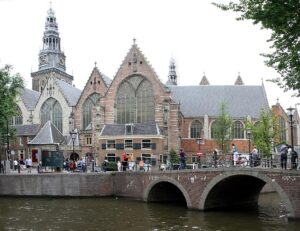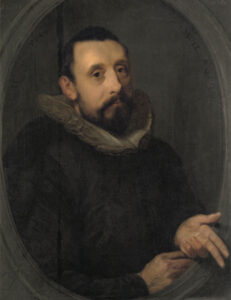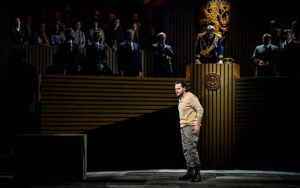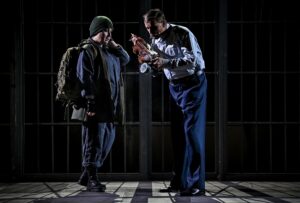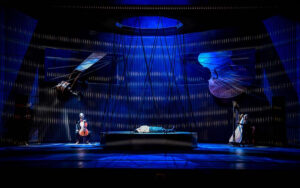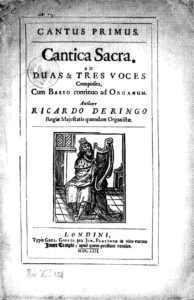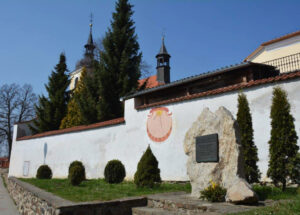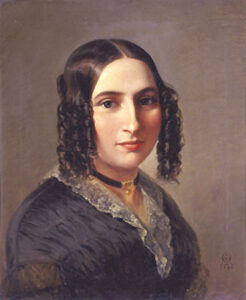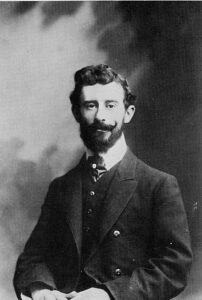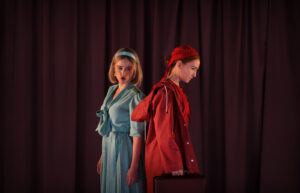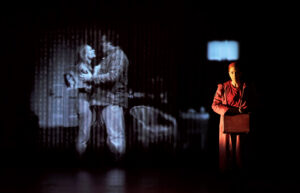Orfeusz z Deventer
Lada chwila recenzja z Dalibora w wersji angielskiej, później kolejne raporty z zagranicy (jak to się wszystko piętrzy!), a tymczasem następny z zapomnianych w archiwum esejów – o Janie Pieterszoonie Sweelincku i jego rodzinnym mieście. Prawie półtora roku temu, na bożonarodzeniowej odsłonie festiwalu Actus Humanus, opracowania jego utworów grała Monika Kaźmierczak: na carillonie gdańskiego kościoła św. Katarzyny.
***
Patron miasta Deventer urodził się przeszło tysiąc dwieście lat temu. Nie wiadomo, czy wychował się w rodzinie nawróconych pogan, czy sam przyjął wiarę chrześcijańską, którą z czasem umocnił na tyle, by uczynić ją podstawą swojej życiowej misji: powrotu do kraju przodków i dokończenia dzieła chrystianizacji północno-zachodnich ziem Franków. Lebuin – bo tak miał na imię – wychowany w opactwie świętego Wilfryda w Ripon, u podnóża Gór Pennińskich w dzisiejszym hrabstwie North Yorkshire, od wczesnej młodości szedł za przykładem dwóch anglosaskich głosicieli dobrej nowiny: apostoła Fryzów Wilibrorda i jego ucznia Bonifacego Winfryda, późniejszego apostoła Germanów. W wielką podróż za wielką wodę Lebuin wyruszył w roku 754: Grzegorz, ówczesny rządca diecezji w Utrechcie, powierzył mu misję dalszego nawracania niewiernych Fryzów i Sasów. Kilkanaście lat później Lebuin wzniósł drewniany kościół na wschodnim brzegu rzeki IJssel, dając początek niewielkiej wiosce Deventer, położonej korzystnie na szlaku wodnej przeprawy handlowej.
Pierwszy kościół nie wytrwał długo, podobnie jak Lebuin, który po zniszczeniu świątyni przez Sasów wrócił do Deventer z misją jej odbudowy i wkrótce sam zginął w zgliszczach nowego przybytku, puszczonego z dymem w kolejnym akcie plemiennego odwetu. Nadrzeczny handel kwitł jednak w najlepsze, a mieszkańcy Deventer konsolidowali się w coraz silniejszą wspólnotę. W końcu IX wieku błyskawicznie odbudowali swoją osadę po najeździe Wikingów. W roku 956 wyjednali dla niej prawa miejskie i obudowali wcześniejsze ziemne obwałowania solidnym murem z kamienia. Złoty wiek Deventer trwał przeszło pół tysiąclecia. W czasach, kiedy za sól płacono bajońskie sumy, miasto bogaciło się na handlu sprowadzanym z Norwegii sztokfiszem: niesolonym, suszonym na drewnianych żerdziach mięsem dorsza, które – przechowywane w odpowiednich warunkach – nadawało się do jedzenia nawet przez kilka lat. To w Deventer powstała jedna z pierwszych hanz niderlandzkich, a wkrótce potem deventerczycy zaczęli bić własną monetę. To tu i w Haarlemie powstawały pierwsze książki odbijane z klocków drzeworytniczych, jeszcze przed wynalazkiem druku ruchomymi czcionkami. To właśnie tutaj, w 1340 roku, urodził się Geert Groote, kaznodzieja i założyciel pietystycznej Wspólnoty Dobrego Życia, z której nauk czerpali między innymi Tomasz à Kempis i Erazm z Rotterdamu.
Willem Blaeu, mapa Deventer (1652)
W roku 1562, kiedy w Deventer przyszedł na świat Jan Pieterszoon Sweelinck, miasto dożywało ostatnich chwil swej świetności. Poziom wody w rzece systematycznie się obniżał, a wraz z nim spadała rentowność portu przeładunkowego. Wielkimi krokami zbliżała się wojna osiemdziesięcioletnia – o wyzwolenie Niderlandów spod panowania Hiszpanów. Kryzys epoki znalazł też odbicie w historii rodzinnej kompozytora. Jan był pierworodnym synem Pietera Swibbertsa, organisty w ówczesnej katedrze św. Lebuina, oraz jego żony Else Sweelinck, córki miejscowego chirurga. Wszystkie dzieci z tego związku przybrały nazwisko matki, gdyż ojciec był bękartem, jednym z siedmiorga progenitury katolickiego księdza Swibberta van Keizersweerd, również organisty, oraz jego kochanki Wibbe Moring.
Niewiele wiadomo o dzieciństwie i wczesnej młodości Sweelincka: poza tym, że w roku 1564 jego rodzice przenieśli się do Amsterdamu, gdzie Pieter objął posadę w Oude Kerk i wkrótce potem zajął się także edukacją muzyczną syna. Zmarł, zanim chłopak skończył jedenaście lat. Wiele wskazuje, że o dalsze kształcenie Jana zatroszczył się następca Pietera w „starym kościele”, śpiewak, organista i kompozytor Cornelis Boscoop. W innych przekazach pojawiają się też nazwiska organistów z Haarlemu – jeśli nawet Sweelinck formalnie nie był ich uczniem, z pewnością stosowana przez nich praktyka codziennych improwizacji na głównych organach haarlemskiego Grote Kerk wywarła ogromny wpływ na jego późniejszą wrażliwość i wyobraźnię dźwiękową. Wciąż jednak pozostaje zagadką, skąd nabył pewne elementy warsztatu kompozytorskiego, których zdaniem badaczy nie mógł wyuczyć się sam: zaskakujące pokrewieństwa stylistyczne jego toccat i fantazji z twórczością Andrei Gabrielego, od 1566 roku organisty bazyliki św. Marka, stały się źródłem niepotwierdzonej hipotezy, że nastoletni Jan pobierał też nauki w Wenecji.
Oude Kerk w Amsterdamie. Fot. Gerd Eichmann
Organistowską schedę po ojcu Jan Sweelinck przejął nie później niż w roku 1580 – w każdym razie już wówczas zarabiał w Oude Kerk niebagatelną kwotę stu złotych florenów rocznie. Amsterdamczycy wysoko cenili jego rzemiosło: pięć lat później, kiedy po śmierci matki musiał się zająć utrzymaniem młodszego rodzeństwa, jego pensja wzrosła dwukrotnie. Po reformacji w Niderlandach Oude Kerk został świątynią kalwinistów: nic więc dziwnego, że Jana zachęcono do rychłego ożenku, i to dodatkiem motywacyjnym w wysokości kolejnych stu florenów. Kiedy Sweelinck wywiązał się z obowiązku wobec wspólnoty, rajcy przyznali młodej parze dodatkowy bonus w postaci zakwaterowania na koszt miasta. Muzyk do śmierci w 1621 roku nie wytknął nosa poza Niderlandy i wyjeżdżał z Amsterdamu wyłącznie w sprawach służbowych.
W mieście nazywano go jednak Orfeuszem, a jego słynne improwizacje ściągały do świątyni tłumy słuchaczy z całej Europy. Zawrotna popularność organisty w ówczesnym Amsterdamie jawi się jako swoisty paradoks: kalwini nie dopuszczali użycia żadnych instrumentów podczas sprawowania liturgii. Jedynym kościelnym obowiązkiem Sweelincka były zatem występy przed nabożeństwami i po nich, a ich celem „praktycznym” było wprowadzenie wiernych w melodie stanowiące podstawę protestanckich hymnów. Jan Pieterszoon nie musiał komponować muzyki dla Oude Kerk. Z rzadka dostawał zamówienia od rajców miejskich, na utwory pisane z myślą o mniejszych instrumentach: klawesynie, wirginale, organach przenośnych. Nieomal całą swą potężną inwencję twórczą angażował w opracowania psalmów i organowe improwizacje, które dały początek większości jego kompozycji na instrumenty klawiszowe: dziesiątkom preludiów, toccat, fantazji i wariacji. Z pewnością pisał też z myślą o swych licznych uczniach, wśród których znaleźli się między innymi Niemcy Jakob Praetorius i Peter Hasse oraz niemiecko-szwedzki kapelmistrz Andreas Düben.
Portret Sweelincka pędzla jego brata Gerrita Pietersza (1606). Ze zbiorów Kunstmuseum Den Haag, obecnie w ekspozycji Amsterdam Museum
Sweelinck był kosmopolitą, który nie musiał podróżować po świecie, bo sam świat do niego wędrował. Był artystą prawdziwie wolnym, który w tamtej burzliwej epoce mógł swobodnie przerzucać mosty nie tylko między odchodzącą w przeszłość stylistyką renesansu a kształtującą się dopiero estetyką baroku, lecz także między wyznaniami – katolicyzmem, kalwinizmem i luteranizmem – z których każde odcisnęło się nieomylnym piętnem na jego twórczości. Wiele mógł. Wiedział, co naprawdę musi. Nie ciążył na nim obowiązek uświetniania wszelkich miejskich uroczystości dźwiękami carillonu. A przecież Jan Pieterszoon zostawił po sobie wystarczająco obfity korpus dzieł klawiszowych, żeby współcześni karylioniści mogli zeń czerpać do woli. Jak w dawnej, złotej epoce mieszkańcy Deventer, czerpiący z bogactw, które wpływały do portu na rozlewnej rzece IJssel.


